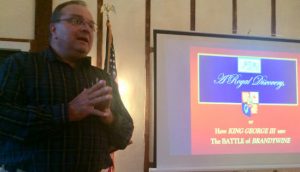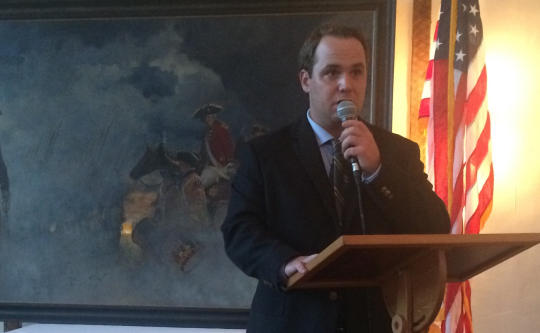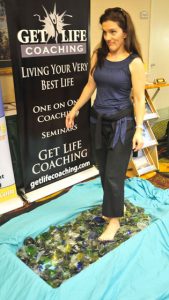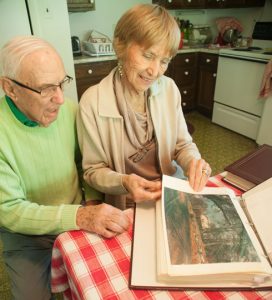How lucky we are to live in an area steeped in history, particularly the bloody Battle of Brandywine, the longest single-day battle of the war, with continuous fighting for 11 hours. We drive on the same roads where British and American troops marched. We walk on the Sandy Hollow trail where for fifty-one minutes British and American troops pushed each other back and forth. Some of us vote at the Birmingham Meeting, which served as a hospital during and after the fighting. We jockey for right of way at the five-way stop in the village of Dilworthtown, where the British commandeered the inn where we still dine today. We travel down Oakland Road from Dilworthtown and pass Harvey Road where some of the heaviest fighting took place at nightfall.
The battle was part of Sir William Howe’s campaign to take Philadelphia (then our nation’s capital) and it included more troops than any other battle of the American Revolutionary War (1775-1783). We are fortunate to have people who devote years of study to this battle and are eager to share their knowledge with us.
On Tuesday, September 18, author and historian Thomas J. McGuire kicked off The Brandywine Battlefield Park Associates’ six-part “Revolutionary Dining Series.” McGuire, a teacher at Malvern Prep School, presented “

using the incredible “Archibald Robertson Map” as a visual aid. The filled-to-capacity audience enjoyed a delicious dinner and open bar in the Gables of Chadds Ford’s private upstairs dining room before the talk began. The attendees listened with rapt attention and asked knowledge-based questions following the lecture.
McGuire discovered The Robertson Map of the Battle of Brandywine in the King's Map Collection at Windsor Castle in 2000 and was able to obtain a copy. We are the beneficiaries of the fact that King George III was a Renaissance man who was interested in lots of things—including maps. Captain Archibald Robertson, a competent artist and talented army engineer, created this amazing document three days after the battle and King George placed it in his collection. Robertson did not draw from imagination; he drew what he was looking at in front of him. According to McGuire, this is the “Rosetta Stone” of the Battle of Brandywine.
Robertson was an eyewitness and participant in the battle. His carefully surveyed map is the most detailed image we have of the battlefield on September 11, 1777. Robertson included fences, woodlots, buildings, and detailed topography. Robertson measured the distance from one point to another by the gait of his horse and then transferred it to the map with one inch representing 500 feet. Together with a four-page key, Robertson documented the main parts of the battle, namely Charles, Lord Cornwallis's flank attack and Wilhelm von Knyphausen's push across Chads's Ford. The map is critical for understanding what actually happened at Brandywine. It also corrects and clarifies many of the primary written accounts of the battle.
McGuire concluded his talk by grimly observing, “The Brandywine Battlefield Park is a beautiful park—but at what a cost.” The one-day battle at Brandywine cost the Americans more than 1,100 men killed or captured while the British lost approximately 600 men killed or injured.
The next lecture in the “Revolutionary Dining Series,” hosted once again by The Gables at Chadds Ford, will feature Robert Selig, Ph.D., on Tuesday, October 23 beginning at 6 p.m. Dr. Selig will speak about what the British and Americans did with all the bodies after the battle. “Of Skull, Severed Limbs and Skeletons: What to do with a Dead American, British, Hessian, or French soldier, as the case may be?” promises to be informative and thought provoking. For more information on the “Revolutionary Dining Series,” please visit www.brandywinebattlefield.org
About Lora B. Englehart
Lora has a passion for art, gardening, yoga, music and dancing. She continues to research the life of locally born abolitionist and 1998 National Women's Hall of Fame inductee Mary Ann Shadd Cary. She is a dedicated community volunteer, working with the American Association of University Women, Wilmington, DE branch (programs chair), Chadds Ford Historical Society (former board member) and Brandywine Conservancy & Museum of Art. Lora lives in Birmingham Township with her husband Bill and son Brad. Daughter Erika lives in Pittsburgh with husband Bob and baby Wilhelmina. She is a former French, Spanish and ESL teacher, bilingual life insurance underwriter and public relations coordinator for Delaware Art Museum and Brandywine Conservancy & Museum of Art.





Comments